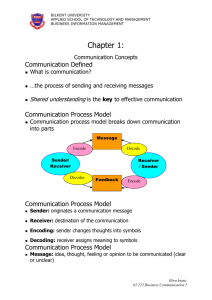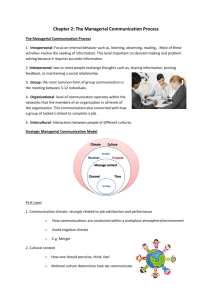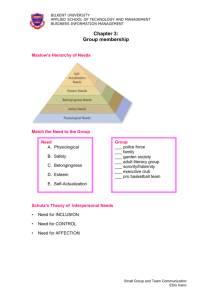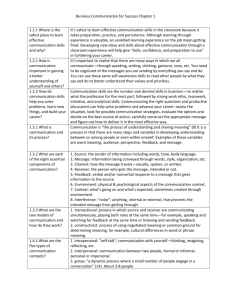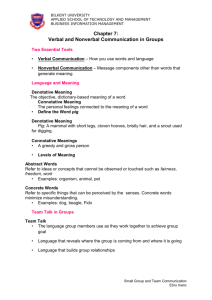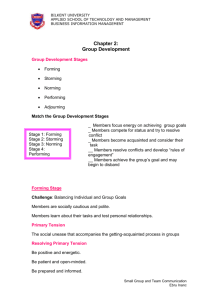1 - Business Information Management
advertisement
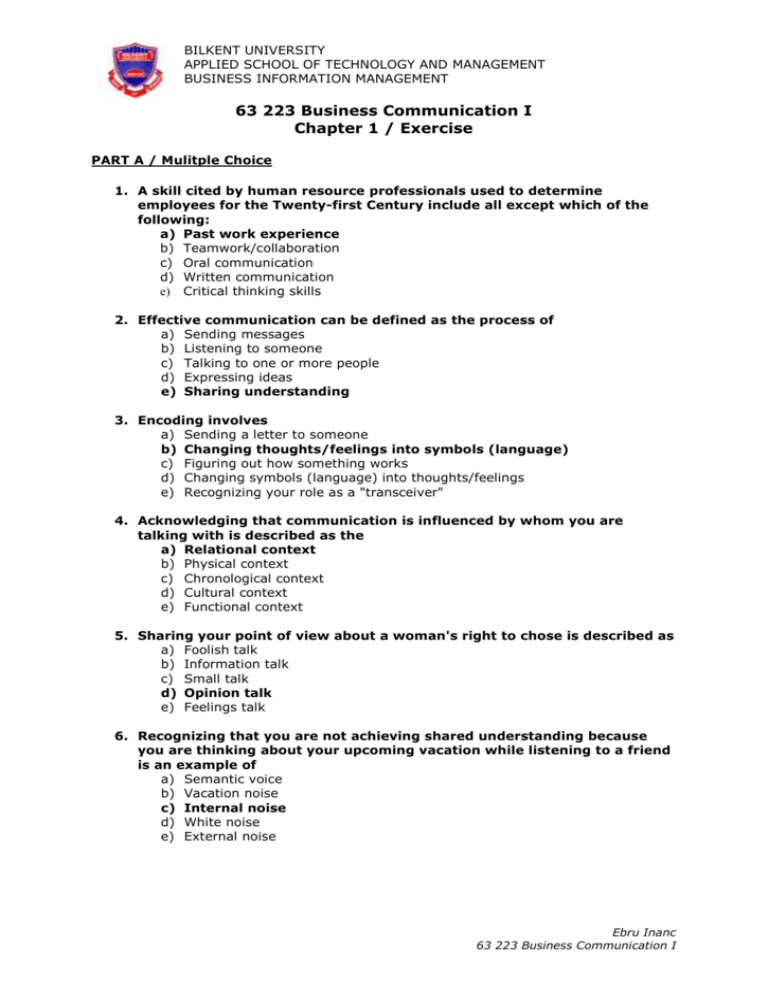
BILKENT UNIVERSITY APPLIED SCHOOL OF TECHNOLOGY AND MANAGEMENT BUSINESS INFORMATION MANAGEMENT 63 223 Business Communication I Chapter 1 / Exercise PART A / Mulitple Choice 1. A skill cited by human resource professionals used to determine employees for the Twenty-first Century include all except which of the following: a) Past work experience b) Teamwork/collaboration c) Oral communication d) Written communication e) Critical thinking skills 2. Effective communication can be defined as the process of a) Sending messages b) Listening to someone c) Talking to one or more people d) Expressing ideas e) Sharing understanding 3. Encoding involves a) Sending a letter to someone b) Changing thoughts/feelings into symbols (language) c) Figuring out how something works d) Changing symbols (language) into thoughts/feelings e) Recognizing your role as a "transceiver" 4. Acknowledging that communication is influenced by whom you are talking with is described as the a) Relational context b) Physical context c) Chronological context d) Cultural context e) Functional context 5. Sharing your point of view about a woman's right to chose is described as a) Foolish talk b) Information talk c) Small talk d) Opinion talk e) Feelings talk 6. Recognizing that you are not achieving shared understanding because you are thinking about your upcoming vacation while listening to a friend is an example of a) Semantic voice b) Vacation noise c) Internal noise d) White noise e) External noise Ebru Inanc 63 223 Business Communication I BILKENT UNIVERSITY APPLIED SCHOOL OF TECHNOLOGY AND MANAGEMENT BUSINESS INFORMATION MANAGEMENT 7. Arguing with your elderly neighbor because you both just don't have the same view of the world is an example of a a) Generation gap b) Gap clothing c) Culture gap d) Cultural gap e) Gender gap 8. Noting how employees interact at work, how managers treat their subordinates, and how promotions are granted reflect the a) Physical context b) Relational context c) Corporate culture d) Functional context e) Ethnic culture 9. Withholding information about an employee who has been stealing at work is an example of which communication principle? a) Communication occurs at different levels b) Communication has its limitations c) Communication requires ethical choices d) Communication is unavoidable e) Communication occurs within a context 10.E-mailing your teacher a question, listening to lectures on podcasts, sending assignments in via your laptop are examples of a) Being addicted to technology b) Techno-phobia c) Impersonal communication d) Technology influencing your occupation e) Technology influencing your learning PART B / True-False 1. The functional context refers to where the communication takes place. True False 2. Semantic noise occurs when the receiver of a message has a different meaning for the word or gesture. True False 3. Communication can solve all of your interpersonal problems. True False 4. Coworkers voicing political viewpoints over lunch or classmates telling each other the perspectives they have on the school grading policies are examples of opinion talk. True False 5. The channel is the medium through which the message travels from sender to receiver. True False Ebru Inanc 63 223 Business Communication I BILKENT UNIVERSITY APPLIED SCHOOL OF TECHNOLOGY AND MANAGEMENT BUSINESS INFORMATION MANAGEMENT 6. This process of assigning meaning to symbols is called encoding. True False 7. External noise can be present when technicians use jargon with laypersons. True False 8. Feedback is the receiver's indication of how the message is seen, heard, and understood, and often how the receiver feels. True False 9. Small talk is the level of conversation that enables you to establish contact with others and build rapport. True False 10. Communication is unavoidable. True False PART C / Short Answer Questions 1. Please explain the types of channels within an organisation . Downward Channels: passing information from superior to subordinate to; • give job instructions • bring about understanding of the job • provide information about procedures • provide feedback about performances of subordinates b. Upward Channels: provides subordinates to convey information to their superiors to; • gain feedback and learn about problems that affect efficiency, • evaluate employee attitudes and perceptions c. Lateral Channels: conveying information between individuals and units on the same hierarchical level for; • the coordination of tasks • sharing of information, • problem solving • conflict resolution This type of communication is persuasive and suggestive rather than directive or authoritative d. Informal Channels: grapevine Single-strand: Each person recieves information from one person and passes it on to one more Gossip: one individual passes the news to all others Probability: Information is passed on randomly Cluster: Channel members selectively choose their informal communication links Ebru Inanc 63 223 Business Communication I BILKENT UNIVERSITY APPLIED SCHOOL OF TECHNOLOGY AND MANAGEMENT BUSINESS INFORMATION MANAGEMENT 2. Please explain the barriers to communication; problems caused by the sender, problems in transmission, problems caused in reception and problems in receiver Barriers to Communication / Problems caused by the sender The amount of information the individual has about the subject of the message Not much information Too much knowledge Indecission regarding how to present the information The order of the presentation Lack of familiarity with the audience Emotional conflict Lack of experience in speaking or writing Barriers to Communication / Problems in transmission Illegible material as a result of poor typing, poor photocopying, poor handwriting Poor acustics Use of too many transmission links Transmission of conflicting messages Barriers to Communication / Problems in reception The surrounding environment Receiver’s physical condition Receiver’s failure to pay attention to the message – Simultaneous receipt of two or more messages – Receiver is bored Barriers to Communication / Problems in receiver comprehension Receiver may not understand some of the words used Personal interests Emotional responses Ebru Inanc 63 223 Business Communication I
